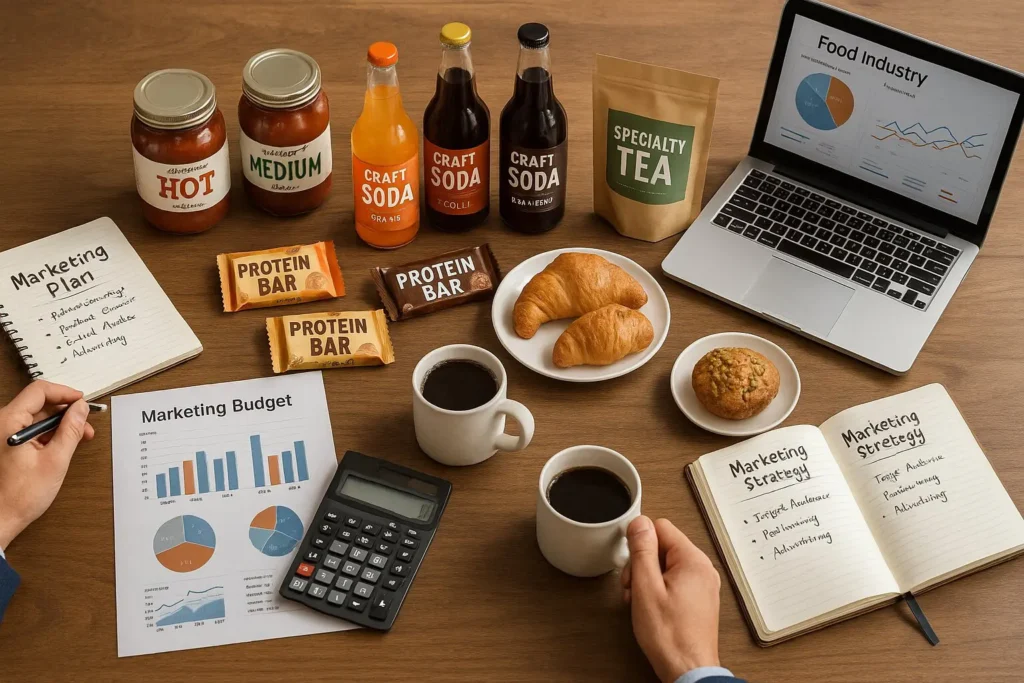Here’s the truth nobody talks about: Most food and beverage companies pay in-house marketers $75K-$150K annually—and that’s before factoring in actual advertising costs like digital ads, influencer marketing, etc. But here’s what keeps me up at night: half of them are making the wrong choice. They’re hemorrhaging budget while their competitors steal market share.
Look, I’ve watched brilliant food brands make this decision poorly. The results? Painful. Six months of spinning wheels. Budgets evaporated. Growth stalled. Meanwhile, their smarter competitors are capturing the customers they should have won.

The Uncomfortable Reality of Food & Beverage Marketing in 2025
The rules changed while you weren’t looking. Over half of Americans now buy groceries online. Digital food commerce is racing toward $85 billion this year. Your grandmother’s marketing playbook? It’s dead.
But most brands are still making decisions like it’s 2019.
They obsess over hourly rates instead of asking the real question: What actually drives revenue? They compare agency costs to internal salaries without factoring in the hidden expenses that’ll bite them later. They think they’re being smart. They’re being penny-wise and pound-foolish.
What Agencies Actually Cost (The Real Numbers)
Food and beverage marketing agencies don’t work for peanuts. Here’s what you’re really looking at:
Hourly rates range from $50 to $300. Monthly retainers? Anywhere from $750 to $5,000 for serious work. Strategic projects start at $10,000 and climb fast if you want something that actually moves the needle.
Do the math. A comprehensive agency partnership will run you $50K to $120K annually for a mid-market brand. Enterprise-level programs? You’re looking at $200K or more.
That sounds expensive until you consider the alternative.
What Internal Teams Actually Cost (The Hidden Truth)
Here’s where most CEOs and entrepreneurs get blindsided. They think they’re hiring a marketing manager for $65K. Wrong.
You need a marketing manager at $61K to $75K. Add a digital specialist at $45K to $65K because nobody can do everything well anymore. Throw in a content creator at $40K to $55K because content is king, but good content creators are expensive.
Now add 25% to 30% for benefits and overhead. Don’t forget tools—another $5K to $15K annually for software that actually works.
Your “affordable” internal team just cost you $125K to $175K. And that’s before anyone gets sick, quits, or turns out to be bad at their job.
The Costs Nobody Warns You About
Every option has landmines. Let me save you from stepping on them.
$75K-$150K
annually on marketing
$50K to $120K
annually for mid-market brand
$125K to $175K
for internal team
Over half of Americans buy groceries online
$85 billion
digital food commerce
Agency Landmines
Agencies need time to understand your brand. Two to three months before they hit their stride. They’re juggling other clients, so you might not get their A-team when you need it most. Scope creep is real—every “small additional request” comes with a price tag.
And here’s the kicker: some agencies talk a big game but don’t really understand food and beverage. They’ll apply generic strategies to your unique challenges. Recipe for disaster.
Internal Team Landmines
Good marketing talent is scarce. You’ll spend three to six months finding the right people. Maybe longer. Training costs $10K to $20K per person annually if you want them to stay current.
But here’s what really hurts: management overhead. Someone senior needs to spend 20% to 30% of their time managing these hires. That’s expensive leadership bandwidth.
And if you hire wrong? You’ve just lost six to twelve months of market opportunity while competitors eat your lunch.

When You Should Choose an Agency
Some situations scream “hire an agency.” Don’t fight it.
You need results yesterday. The food industry doesn’t wait. New product launch? Competitive threat? Seasonal opportunity? Agencies bring playbooks they’ve refined across dozens of brands. They’ve made the mistakes on someone else’s dime.
Your revenue is under $10 million. The economics are simple. Agency costs scale with your needs. Internal teams eat fixed overhead whether you’re growing or struggling.
You don’t speak about food marketing fluently. FDA regulations, seasonal planning, retail relationships, supply chain crisis management—this stuff is specialized. Generic marketers will learn on your budget. Expensive education.
You want predictable monthly expenses. Agency retainers give you budget certainty. No surprise salary bumps or benefit costs.
You need a full skill stack but can’t afford five specialists. One agency can provide strategy, creative, digital advertising, PR, and analytics. Good luck hiring all that talent internally without breaking the bank.
Track what matters: customer acquisition cost, return on ad spend (aim for 4:1 minimum in F&B), market share growth, and retail placement success.
When You Should Build Internal
Sometimes internal teams make perfect sense. Here’s when.
Your revenue exceeds $25 million. At this scale, the math flips. You can afford specialists like Category Marketing Managers and Trade Marketing experts. The cost savings become real.
You have complex, ongoing needs. Constant content creation, community management, technical support—these benefit from dedicated attention. Agencies split focus across clients.
Brand control matters deeply to you. Internal teams live and breathe your brand voice. They won’t accidentally dilute your message while juggling ten other client priorities.
You’re thinking long-term. Two to three years of consistent marketing investment? Internal teams offer better value over time. Just make sure you’re truly committed.
You have strong marketing leadership. This is crucial. Internal teams need experienced guidance or they’ll devolve into tactical busy work. Strategy matters.
Track revenue per marketing employee, campaign development speed, brand consistency scores, and employee retention rates.
The Smart Money Play: Hybrid Approach
Many successful food brands thread the needle with hybrid models.
Keep one or two full-time marketers for brand management and daily operations. Budget $75K to $125K annually. Partner with specialized agencies for paid advertising, creative development, or PR. Add $25K to $75K for project-based or retainer work.
Total investment: $100K to $200K. Maximum flexibility and expertise.
You get dedicated brand stewardship plus specialized skills without the overhead of a full team or the divided attention of pure agency relationships.
What Makes Food Marketing Different
Don’t underestimate these industry specifics.
Regulatory compliance isn’t optional. FDA regulations, claims substantiation, nutritional labeling—mess this up and you’re looking at fines, recalls, and reputation damage. Food marketing agencies understand these minefields. General marketers learn by making expensive mistakes.
Seasonal planning drives everything. Holiday seasons, back-to-school, summer grilling—food brands live and die by seasonal execution. Experienced agencies have playbooks ready. Internal teams build this knowledge slowly.
Retail relationships are complex. Grocery placement, trade marketing, retailer-specific requirements—this is specialized knowledge that takes years to develop.
Supply chain crises happen. When quality issues or shortages hit, you need crisis communication expertise. Fast. Food agencies understand this. Generic marketers panic.
Your Decision Framework
Stop overthinking. Here’s how to decide.
First, calculate your real budget. Include everything: salaries, benefits, tools, management time, opportunity costs. Food brands typically budget 3% to 6% of revenue for marketing.
Second, assess your internal capabilities honestly. Do you have marketing leadership experience? Can you manage specialists effectively? Do you understand food marketing challenges? Be brutal in your self-assessment.
Third, define your timeline. Need results in three to six months? Agency. Planning two to three years of investment? Consider internal. Want maximum flexibility? Hybrid.
Fourth, evaluate your risk tolerance. High growth pressure demands proven expertise. Stable growth plans can support internal development. Complex brands benefit from hybrid approaches.
The Hard Truth
This isn’t just about saving money. It’s about growth velocity, risk management, and competitive advantage.
Choose agencies when you need immediate expertise, predictable costs, and proven food industry knowledge. Choose internal teams when you have management bandwidth, long-term commitment, and revenue scale to justify fixed overhead. Choose hybrid when you want flexibility and can strategically combine internal brand management with external specialized expertise.
But whatever you choose, measure everything. Track customer acquisition costs, return on ad spend, revenue attribution. Marketing without measurement is just expensive guessing.
Book a strategic consultation to review your specific situation, budget parameters, and growth objectives. We’ll help you build a marketing investment framework that drives measurable revenue growth in 2025 and beyond.
Stop Wasting Your Budget
The food and beverage industry doesn’t wait for perfect marketing strategies. Your competitors aren’t paralyzed by this decision—they’re already capturing market share while you debate options.
Make an informed decision quickly. Measure results consistently. Adjust based on data, not emotions.
The $75K you spend this year will either accelerate your growth or subsidize your competitors’ success. Choose wisely.



